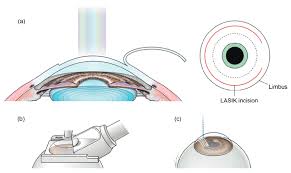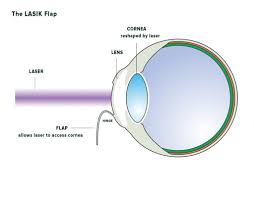Table of Contents
ToggleIn recent years, advancements in medical technology have revolutionised the field of eye care, providing numerous options for vision correction. Among these, the terms “laser” and “LASIK” often surface in discussions, leading many to wonder if they are one and the same. While they are closely related and often used interchangeably, they refer to different aspects of vision correction.
This blog aims to dissect the differences and connections between laser eye treatments and LASIK, helping you understand their unique roles in vision improvement.
Understanding Laser Eye Surgery
Laser eye surgery is an umbrella term that encompasses various procedures designed to correct refractive errors by reshaping the cornea—the clear, dome-shaped surface at the front of the eye. This reshaping enhances the eye’s capacity to focus light directly on the retina, leading to improved visual clarity.
Types of Laser Eye Surgery
1. Photorefractive Keratectomy (PRK):
- PRK was the first type of laser eye surgery to be widely performed and is still employed today.
- In PRK, the outer layer of the cornea, known as the epithelium, is removed entirely before reshaping the underlying corneal tissue with an excimer laser.
- The epithelium regenerates naturally after the procedure, but this can result in a longer recovery time compared to other methods.
2. Laser-Assisted Sub-Epithelial Keratomileusis (LASEK):
- LASEK is similar to PRK but involves preserving and repositioning the epithelium rather than removing it.
- After the laser treatment, the epithelial layer is placed back over the cornea to aid in recovery.
- This method can lead to less discomfort and quicker healing than PRK.
3. Laser-Assisted In Situ Keratomileusis (LASIK):
- LASIK is perhaps the most recognised form of laser eye surgery and is known for its quick recovery and high success rate.
- In LASIK, a femtosecond laser or mechanical blade creates a thin flap in the cornea. This flap is lifted so that an excimer laser can reshape the underlying tissue.
- Once the cornea is reshaped, the flap is repositioned, acting as a natural bandage that quickly adheres without the need for stitches.
The Role of Lasers in Vision Correction
The fundamental link between these procedures and the term “laser” lies in the technology used to perform them. Lasers play a crucial role in ensuring precision and accuracy in reshaping the cornea. Two primary categories of lasers are commonly utilized:
1. Excimer Laser:
- This ultraviolet laser is crucial for reshaping the cornea during PRK, LASEK, and LASIK procedures.
- It removes microscopic amounts of tissue with high precision, allowing for accurate correction of sight issues such as myopia (short-sightedness), hyperopia (long-sightedness), and astigmatism.
2. Femtosecond Laser:
- Often used in LASIK surgery, this laser creates the initial corneal flap.
- It operates at incredibly high speeds, allowing for a gentle and precise cut that reduces the risk of complications and improves recovery times.
LASIK Explained
While laser eye surgery refers broadly to the use of laser technology in vision correction, LASIK is a specific type of laser eye surgery. It is distinguished by its use of laser technology to create a corneal flap and reshape the cornea, offering distinct advantages:
Advantages of LASIK
- Quick Recovery: Most patients experience immediate improvements in vision and can return to regular activities within 24 to 48 hours.
- Minimal Discomfort: Thanks to the precise nature of the flap creation and corneal reshaping, discomfort during and after the procedure is minimal.
- High Success Rates: LASIK boasts an impressive success rate, with many patients achieving 20/20 vision or better post-surgery.
Considerations for LASIK
- Eligibility: Not everyone is a candidate for LASIK. Factors such as corneal thickness, eye health, and the degree of refractive error play a role in determining eligibility.
- Cost: LASIK can be more expensive than other types of laser eye surgery, though many consider the benefits to be worth the investment.
- Potential Side Effects: Some patients may experience side effects such as dry eyes, glare, or halos around lights, though these typically diminish over time.
The Distinctions and Connections
While laser eye surgery and LASIK are interconnected, it’s crucial to understand that not all laser eye surgeries are LASIK. LASIK is a type of laser eye surgery, but the term “laser” can refer to various procedures that utilise laser technology to correct vision.
Key Differences
- Procedure: LASIK involves creating a corneal flap, whereas other laser surgeries like PRK remove or preserve the outer layer of the cornea without creating a flap.
- Recovery: LASIK generally offers a faster recovery compared to PRK and LASEK, which may require more extended healing periods due to the regeneration of the corneal epithelium.
- Technology: While all laser surgeries employ lasers, the type and application of the laser can vary; LASIK uses both excimer and femtosecond lasers, whereas PRK and LASEK primarily use the excimer laser.
A Common Goal
Despite their differences, all laser eye surgeries aim to improve vision health and quality of life by reducing dependence on glasses or contact lenses. They offer an invaluable solution for individuals seeking visual freedom and clarity.
Summing Up
Understanding the nuances between laser eye surgery and LASIK can empower you to make informed decisions about your eye care. While LASIK is a popular and effective form of laser eye treatment, it’s essential to consult with a qualified eye care professional to determine which procedure best suits your unique vision needs and health profile.
If you’re considering laser eye surgery, explore the various options available and discuss them with your ophthalmologist. Remember, LASIK might be the best-known procedure, but it’s not the only solution available. Your eye care provider can offer invaluable guidance to help you achieve the best possible outcome for your vision.
For those eager to learn more about how laser technology is revolutionising vision correction or to explore whether you’re a candidate for LASIK or another form of laser eye surgery, don’t hesitate to book a consultation with a reputable eye care specialist. Your path to clearer vision begins with understanding your options—and now you’re one step closer.













